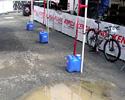
Recently on Cyclingnews.com |
Wrenchin' in the USA: The Chris Davidson diary 2007
Chris joins us again in 2007 to report on life on the road turning the wrench for a variety of teams both in dirt and on the road. Formerly with Ford Cycling in 2006, Chris has also worked for such teams as T-Mobile, Equipe Nurnberger, Quark and Mercury in the past, as well as neutral support programs with Shimano, Pedros and Trek.
As 2007 holds some new challenges for Chris, some things will stay the same. One of those will be his informative diary contributions on Cyclingnews, where you'll often receive the inside scoop on all things tech and a look at life behind the wrench.
August 3, 2007
Off in the mud

|
Greetings Cyclingnews readers. First off I must apologize for the lack of reports from both the Mt Snow National Championship and Sugar Mountain NMBS races. The excuses for the lack of updates can be enumerated like this, in descending order of importance:
1. Mud
2. Rain, cold temperatures and humidity
3. Mud
4. Lack of wireless internet connectivity
5. Mud
6. Travel logistics
I had to travel to the east coast for both of these two events and that usually means an increase in the levels of humidity that I am used to in the west. However, for two straight weekends the humidity for both Mt Snow and Sugar Mountain was greater than 100% most of the time. This leads to items 1, 3 and 5 above.
Bikes ridden at both venues required both 1+ hour washings, then meticulous relubing, swapping cables and housing, new chains, etc. Easily both weekends involved 12+ hour days to attend to four race bikes. Add to that working and washing in the rain at times and I was a pretty soggy mechanic at the end of the day, hence the lack on touching electronic devices such as my camera and laptop.
There are some advanced techniques that I employ in nasty conditions that may be of some interest to techy readers out there. The first would be for mud build-up on frames. Some like to add fenders to the bike, both commercial available ones and homemade soda bottle variants. I am not a fan of these, but I defer to the rider choice when they are trying to keep mud out of their eyes.

|
Instead I prefer to spray key mud build-up parts of the bike with Pam cooking spray. I suggest that you try this locally and see if it works for you, as some variations in soil/mud conditions work well, others not so well. I usually try to spray the back of the seat tube/seat post, under the saddle, the down tube and the back of the fork crown. Be liberal with this stuff, it easily washes off with soap and water after, and more rather than less helps mud from getting a grip on the frame tubes. Makes your bike transiently smell like fried chicken too. Bonus!
The second area would involve drivetrains. This is the most difficult part to keep 100% functional in nasty conditions. For both Mt Snow and Sugar Mountain I was using a two part approach. First, after a complete washing of the drivetrain and an overnight to dry, I use the heaviest lube we have (in this case Pedros SynLube) and I apply it liberally to the chain and rub the chain with my hands (covered with nitrile gloves of course) to get the lube really worked into the chain.
After a few minutes of this I wipe the chain down with a rag. Next I wait about 10 minutes, watching the chain for evidence of excess lube still dripping out from between the links and pins. If this is the case, then I know that I have used enough lube.
Next is where it gets really messy. I then add grease to the chain with my index finger. I try to spread a light layer over the entire chain, then I rub this grease into the links with my gloved hands. The aim is to seal the chain lube into the spaces between the links and pins (much like the rubber seals on a motorcycle chain) with the grease.

|
After a thorough rubbing of the grease into the chain links I wipe the chain only minimally with a rag. In bad conditions I try to do this treatment just before the rider heads to the start line (i.e. keep the bike clean as long as possible). If they are going to warm-up on a trainer I usually wait for the heavy lube/grease treatment until just before they head out on the course. It is going to be messy afterwards, and require a through cleaning, but I have found this procedure to work well in muddy, wet conditions. Road mechanics in Europe are known to add grease to the chains in wet weather to help the drivetrains last for a 200km day in the wet.
So imagine 3+ pounds of mud accumulation and a very greasy, dirty chain to clean up each day, times four bikes and you can see that the day quickly gets eaten up with the wash. I bought a new waterproof jacket and pants before I headed to Vermont and they proved to be worth their weight in gold over the two weekends.
Back to the list above. For #4 and #6, both locations were pretty far out in the woods, so the lack of internet connectivity did not surprise me. At the end of the day I was often too tired to head out and find a café with some internet. And as for the travel, finding major airports with amenable flight schedules was difficult, in addition the venues required 2+ hour drives from the airports to get there. Both weekends I found myself on Thursday nights driving from the airports on small roads, blinded by fog and rain, trying to find the team's condo. After midnight in both cases.
So while the lack of reports is not acceptable to some degree, local conditions must be drawn into consideration. However, even with the experience of these last two weeks, I am looking forward to Aspen and the series finale in two weeks. The climate is always drier at 9000ft, and when it does rain, it lasts for 30 minutes and then it gets sunny and hot again. It might even be a little dusty up there, but at this point that would be a relief from the mud. I hope to see you there, you can leave the Pam at home for this one.
Thanks,
Chris Davidson
